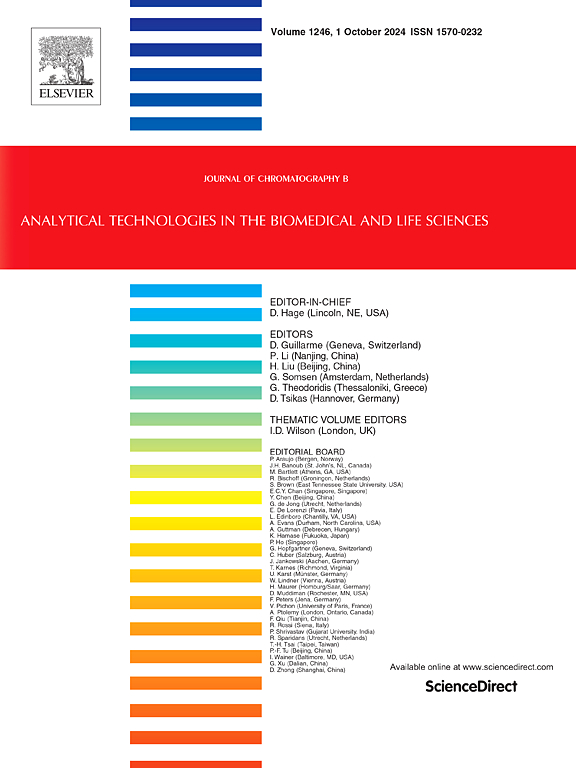A superior method for the estimation of Molnupiravir and its metabolite and degradation product, Beta-D-N4-Hydroxycytidine, in human plasma with dexamethasone
IF 2.8
3区 医学
Q2 BIOCHEMICAL RESEARCH METHODS
引用次数: 0
Abstract
Molnupiravir (MOL) is a versatile drug in treating COVID-19. It is activated directly after absorption into D-N4-hydroxycytidine (MET), which resembles the viral substrate cytidine or uridine. Dexamethasone (DEX) is used as an adjuvant medication with MOL to manage symptoms. This work employed microwave irradiation in the hydrolytic degradation of MOL and the synthesis of MET. A white, green, and blue UPLC method was created to estimate the concentrations of MOL, MET, and DEX in human plasma at relevant concentration levels. A BEH® C18 column, a simple mobile phase of acetonitrile and water in a 20:80 ratio, and a flow rate of 0.1 mL/min were employed in the procedure. The antiviral drug favipiravir (FVP) served as the internal standard. The separated drugs were quantified at 230 nm. The validity of the method was justified according to FDA specifications. Performance, greenness, and blueness were compared between the recently created UPLC and the published LC-MS methods. The comparison indicated that our method is greener, bluer, whiter, and more feasible than the published ones. These findings suggest estimating the three medications in human plasma using our proposed method for bioavailability and therapeutic drug monitoring research.
用地塞米松测定莫诺匹拉韦及其代谢物和降解产物β - d - n4 -羟胞苷在人血浆中的含量
Molnupiravir (MOL)是一种治疗COVID-19的多功能药物。它在被吸收为d - n4 -羟基胞苷(MET)后被直接激活,后者类似于病毒底物胞苷或尿苷。地塞米松(DEX)被用作MOL的辅助药物来控制症状。本研究采用微波辐照水解降解MOL和合成MET。建立白、绿、蓝三色超高效液相色谱(UPLC)法,对相应浓度水平下人血浆中MOL、MET和DEX的浓度进行估计。色谱柱为BEH®C18,流动相为乙腈和水,比例为20:80,流速为0.1 mL/min。以抗病毒药物法匹拉韦(FVP)为内标。分离的药物在230 nm处定量。该方法的有效性根据FDA规范进行了验证。比较了最近创建的UPLC和已发表的LC-MS方法之间的性能、绿度和蓝度。对比表明,该方法比已有的方法更环保、更蓝、更白、更可行。这些发现建议使用我们提出的方法估计人类血浆中的三种药物的生物利用度和治疗药物监测研究。
本文章由计算机程序翻译,如有差异,请以英文原文为准。
求助全文
约1分钟内获得全文
求助全文
来源期刊

Journal of Chromatography B
医学-分析化学
CiteScore
5.60
自引率
3.30%
发文量
306
审稿时长
44 days
期刊介绍:
The Journal of Chromatography B publishes papers on developments in separation science relevant to biology and biomedical research including both fundamental advances and applications. Analytical techniques which may be considered include the various facets of chromatography, electrophoresis and related methods, affinity and immunoaffinity-based methodologies, hyphenated and other multi-dimensional techniques, and microanalytical approaches. The journal also considers articles reporting developments in sample preparation, detection techniques including mass spectrometry, and data handling and analysis.
Developments related to preparative separations for the isolation and purification of components of biological systems may be published, including chromatographic and electrophoretic methods, affinity separations, field flow fractionation and other preparative approaches.
Applications to the analysis of biological systems and samples will be considered when the analytical science contains a significant element of novelty, e.g. a new approach to the separation of a compound, novel combination of analytical techniques, or significantly improved analytical performance.
 求助内容:
求助内容: 应助结果提醒方式:
应助结果提醒方式:


